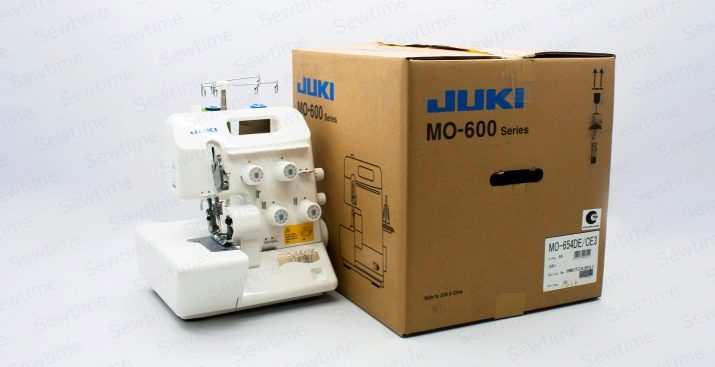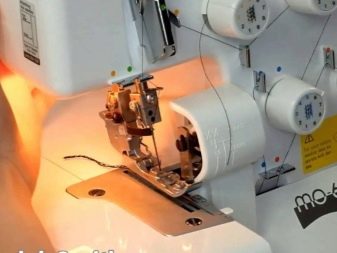Overlock Juki MO-654DE: description, pros and cons, operation

The Japanese company Juki holds a leading position in the market for the manufacture of sewing devices. The company managed to achieve leadership in the production of sewing machines and overlocks for domestic use through the introduction of technologies that are used only in industrial equipment. This made it possible to extend the service life of the units and achieve the professional level of the processed products. In this article, we will take a closer look at one of the creations of this company, the Juki MO-654DE overlock.

About the brand
Juki Company - the world's first brand, whose industrial equipment is used in their work by many renowned design companies: MaxMara, Hugo Boss, Levi's, Giorgio Armani and many others. The history of the Juki trademark begins in 1938, it is associated with the unification of 800 sewing machine manufacturers that took place in Tokyo. 1947 was the year of the release of the first household sewing machine, and 6 years later an industrial design was made. In 1976, the first household overlocks were produced, which are still successfully sold all over the world today.


Juki MO 654DE overlock review
Overlock Juki MO 654DE modification is considered ideal for home use and one of the most sought after patterns for beginners to sew... This is a 2, 3, 4-thread overlocker with an integrated roller folding system and a differential feed (differential feed of material). In total, he performs 14 types of seams, including roller and pseudo-cover Flatlock (imitation of a flat seam).

The model is equipped with the option of adjusting the stitch length from 1 to 4 millimeters.
To change its length, you just need to turn the knob. The stitch length adjuster and differential feed of the fabric are located on the right side, which provides comfortable work without additional steps to open the lid. The overlocker is equipped with a reliable industrial moving knife system. This means that during the operation of the machine, the material will not separate from the blade, and every time the edge will be flawlessly cut.

The maximum speed of the unit reaches 1500 stitches per minute. The machine is equipped with a safety sewing function, and if you open the cover, the knives will stop working. The main difference of this modification is the automatic lower looper feeder. A convenient mechanism makes it possible to thread them with a single touch. The Juki MO 654DE overlocker has the following specifications:
- speed - produces 1500 stitches per minute;
- needles of the standard 130/705 N;
- the number of threads - from 2 to 4;
- number of lines - 15;
- electric motor power - 105 W;
- 2-stage foot lift - 6 and 8 millimeters;
- stitch length from 1 to 4 millimeters;
- seam width - 3-5 millimeters (3-thread), 5-7 millimeters (4-thread);
- knife drive location - top;
- rolled seam lever integrated into the throat plate;
- smooth regulator of presser foot;
- coefficient of differential feed of fabric - from 0.5 to 2.25;
- automatic looper threading machine;
- lamp for illumination of the working area.

Equipment:
- standard foot;
- large screwdriver;
- small screwdriver;
- tweezers;
- set of needles;
- meshes for coils;
- coil clamps;
- dust brush;
- backup knife;
- needle threader;
- converter for 2-thread seams;
- butter dish with butter;
- dust cover;
- manual.


Advantages and disadvantages
The key advantages of an overlock are the following.
- Accuracy of overcasting - the built-in seam guide makes it possible to make precise seam allowances during overcasting as the fabric advances.
- The multifunctional presser foot sews stitches, attaches ribbons, ribbons, patches and sequins. The multifunctional foot can be easily exchanged for a specialized one by using your creative possibilities.
- The extremely strong knife system makes it possible to cut both light and heavy textiles.
- Good illumination of the material and the area around the needle.
- Quick roll-up of the edge of the product.
- The differential feed conveyor allows you to create wavy edges on garments and fabric gathers.
- Easy adjustment of the stitch length.
- Color-coded thread guides - Threads are threaded along precisely marked, color-coded lines.
- Easy adjustment of thread tension by means of a one-way rotation disc with indication of normal tension values for the usual consistent tension adjustment.

Disadvantages:
- there is no garbage bin (it would be more comfortable with it);
- there is no removable sleeve platform;
- there are no specialized legs for certain stitches (you have to buy them separately);
- soft, fragile and unsightly case.


Unit start-up (instruction)
Full information on how to install the unit components is given in the instruction manual. Juki MO 654DE starts to function only after connecting the foot pedal. This should be done in the following order.
- Connect the foot pedal to the overlock by inserting its plug into the dedicated socket (plug) on the body.
- Connect the pedal to the mains.
- Place your foot on the pedal and perform the required operations. By pressing the foot on the pedal, the speed of the unit can be controlled.


Full functioning of the unit possible only after correct threading. This should be done along the multi-colored guides that are present on the device case. The number of spools of thread required depends on the type of overcast chosen (for a 4-thread thread, you need to prepare 4 spools of thread).

Reviews
Reviews about this car are mostly positive. According to consumers, the presented overlock modification is a 100% high-quality and reliable unit that perfectly copes with all the functionality declared by the manufacturer. In the reviews, consumers note that the unit is endowed with such positive properties:
- makes it possible to perform a solid line, which does not differ in any way from the factory one;
- sews fabric of any thickness;
- simply tucked in with threads;
- equipped with a comfortable carrying handle;
- easy to set up;
- does not make noise when working.

They mainly complain about the absence of a waste container, which is needed for the remnants of fabric during overcasting of the edges of products.
For an overview of the overlock, see the video.








